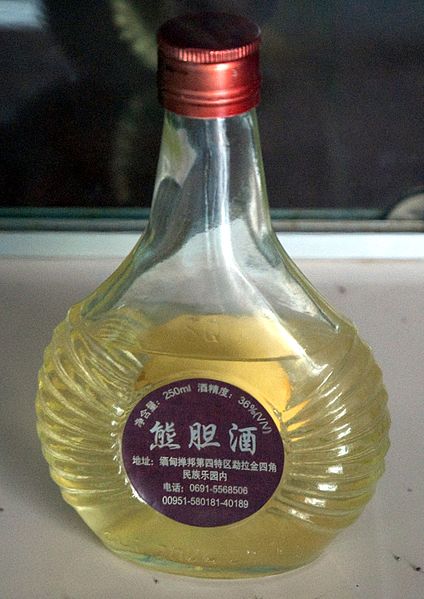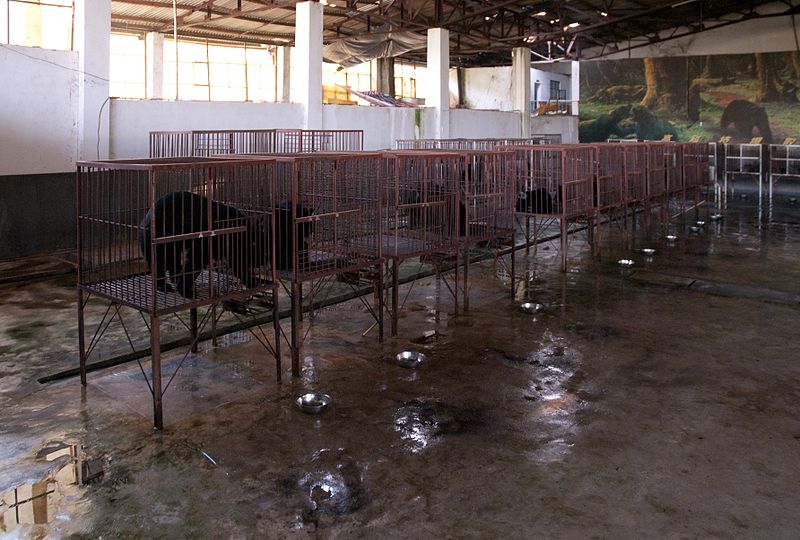Sun Bear (Helarctos malayanus)
Habitat and Vulnerability
The Malayan sun bear being one of the most endangered of the
8 bear species, also happens to be among the least researched.
It is however known that the Malayan sun bear’s top predator happens to
the humans. Humans negatively effect the Sun Bear population in
two ways (ICUN Redlist of Endangered Species).
Humans indirectly effect the sun bear through the expansion of cities and deforestation, but they directly endanger the sun bear in several other ways. Poaching is a common practice that significantly effects the bear population, since the Mayalan sun bear’s assets can be used in many ways (Ecology of the Malayan Sun Bear).
Although the pelt of the Malayan sun bear isn’t the driving
force behind the poaching of the bear, as it is for several
other animal species, it can be used in multiple ways, ranging
anywhere from rugs to clothing. The meat of the sun bear again
isn’t th e
major reason the Malayan sun bear is being poached,
but smaller, rural civilizations are known engage in active poaching
for the sun bear’s meat. The brute force behind the poaching of
this animal is the bear’s bile (Biological Conservation). It serves a wide array of
purposes, ranging anywhere from folk medicine to common
ingredients in many of Asia’s everyday food and beverage
ingredients. Since the gall bladder is believed by many of the
locals to be such an important part of the sun bear, many bears
are being captured and sold to bear farms. The bear is then
killed and it’s bile is processed and in turn sold for large
sums of money. While this practice is slowly becoming less
popular, recent medical research has shown that the sun bear’s
bile produces little to no health benefits. It’s just a myth
that has been passed down from generation to generation in the
rural Asian societies (Biological Conservation).
e
major reason the Malayan sun bear is being poached,
but smaller, rural civilizations are known engage in active poaching
for the sun bear’s meat. The brute force behind the poaching of
this animal is the bear’s bile (Biological Conservation). It serves a wide array of
purposes, ranging anywhere from folk medicine to common
ingredients in many of Asia’s everyday food and beverage
ingredients. Since the gall bladder is believed by many of the
locals to be such an important part of the sun bear, many bears
are being captured and sold to bear farms. The bear is then
killed and it’s bile is processed and in turn sold for large
sums of money. While this practice is slowly becoming less
popular, recent medical research has shown that the sun bear’s
bile produces little to no health benefits. It’s just a myth
that has been passed down from generation to generation in the
rural Asian societies (Biological Conservation).
The problem is that most of the inhabitants of Southeast Asia don’t understand the severity of the poaching that they are engaging in. They aren’t aware that the poaching of these animals can come with major consequences if they are caught. Any killing, eating, or production of the Malayan sun bear is considered a federal offense (Biological Conservation). The problem with this is the fact that this law is rarely enforced by officials. Many people know about the laws against poaching, but continue their practices knowing that the chances of being caught are slim, others are completely oblivious to the fact that the sun bear is endangered. This is due to the fact that much of Southeast Asia is made up of independent rural communities.
Unlike many of Southeast Asia’s other endangered
species, the vulnerability of the sun bear isn’t commonly known.
Others animals in the area such as tigers and other large cats
that are on the Vulnerable Species List have several
organizations backing them and spreading awareness of the
problem (ICUN Redlist of Threatened Species). This helps to
bring attention to their cause. Unfortunately the sun bear’s
endangerment isn’t as widely known. Although more and more
foundations are being formed to help bring to attention the
increasing threat sun bear’s are facing with extinction (ICUN Redlist of Threatened Species).
Also, because one of the sun bear’s important
dietary needs is fruit and the source of their fruit diet is continually
being cut down for logging purposes, the sun bear is forced to look to
other places to obtain this portion of their diet (Journal of Tropical
Ecology). This typically happens to be farmer’s fields. The reason for
deforestation in a major part of these lands, is because this land is
needed to increase the areas agricultural output. The sun bear’s habitat
is being cut down and in it’s place farmer’s are planting huge fields to
grow crops. Unfortunately the bear’s see this as a food source, while
the farmer’s see the bear a threat to food production (Journal of
Tropical Ecology). This has caused the poaching of the sun bear to be
further increased.
Since the number of these bears continue to
dwindle, it has become increasing hard for researchers to track them.
Researchers return time after time to areas that are known to be common
roaming grounds of the bear only to come up empty handed, because their
habitat was destroyed due to the expansion of nearby cities or because
most of the vegetation had been cut down for logging purposes.
Researchers then have to start from square one following possible
bedding sites or scat (Ecology of the Malayan Sun Bear). Since Southeast Asia is home to a wide variety of
animals, it’s easy for biologists to be led amiss. They can follow signs
of what they think to be a Malayan sun bear for days, even weeks, only
to find out that they have been following a different bear species or a
different animal altogether (Ecology of the Malayan Sun Bear). Although the journey can be frustrating,
they’re many devoted biologists
that haven’t given up hope. Among the most well-know is Siew Te Wong. He
has been studying this species of bear since 1998. In a six year span he
only managed to trap a total of ten bears. They were then fit with
tracking collars that allowed their general location to be assessed
(Conservation Biology).
Wong then sets out on foot or in a small bush vehicle to find the bears.
Once Wong believes that he is in the general location of the bear, he
will set out on foot to ensure he didn’t disturb the bear. He then
tracks the bear, from a distance, taking note of the Malayan sun bear’s
diet and habitat ranges (Conservation Biology).
Although the Malayan sun bear is not yet
considered endangered, it remains one of the vulnerable species in the
Conservation Status List. There are several organizations working to
help maintain and eventually repopulate the sun bear population (ICUN
Redlist for Threatened Species). Among
the top of these conservation programs is Siew Te Wong’s Borean Sun Bear
Conservation Centre.
Siew Te Wong's Borean Sun Bear Conservation Centre
